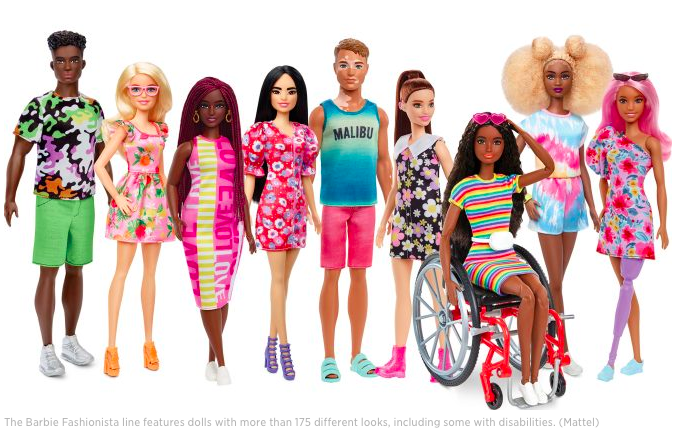Your language-teaching mission, should you choose to accept it, is to explore a variety of resources that discuss the use of Inclusive French.
Image source: https://givingbalkans.org/content/inclusive-language-principles
Below is an ever-growing list of resources that I have been collecting on the use of inclusive French. I will continue to add to this list, in alphabetical order of creator(s), as I come across more helpful or interesting articles and resources. Please feel free to share a link in the comments, which I will add to the list!
I think it is important to point out, as Kris Knisely, Julia Spiegelman, and Blase A. Provitola did in a recent presentation for the Diversity, Decolonization, and the French Curriculum virtual conference, as of 2022, there is no “right way” to use inclusive French. As with everything, context is everything, and it is our job as educators to present a variety of perspectives to our students rather than prescribing how they can be inclusive!
Alpheratz: https://www.alpheratz.fr/linguistique/genre-neutre/
« Lexique de Genre Neutre », qui est un extrait du livre d’Alpheratz “Grammaire du Français Inclusif” (2018).
Un article académique : “Les personnes non-binaires en français : une perspective concernée et militante” par Florence Ashley de McGill University
Diver Genres: https://divergenres.org/wp-content/uploads/2021/04/guide-grammaireinclusive-final.pdf
Un guide pour comprendre et utiliser la grammaire neutre et inclusive par Diver Genres.
Annabelle Dolidon: https://pdxscholar.library.pdx.edu/pdxopen/40/
An open educational resource conversation tool, CITOYEN.NE.S is a French language method for the conversation class at the intermediate/ advanced level. Content and activities are built around the concepts of diversity, inclusivity and equity.
Égale: https://egale.ca/wp-content/uploads/2020/06/French-Inclusive-Language-4.0.pdf
Une glossaire pour l’usage du français inclusif, avec les liens pour les autres ressources et plus d’information.
En Inclusif: https://eninclusif.fr/
Un réécriture automatique des mots de façon inclusive avec le point médian, le point et le tiret à la fois au singulier et au pluriel et avec des options binaire et non-binaire.
En Tous Genres: https://entousgenresblog.wordpress.com/2017/04/19/quels-pronoms-neutres-en-francais-et-comment-les-utiliser/
Un post sur “Le langage neutre en français : pronoms et accords à l’écrit et à l’oral”
Hélène Frohard-Dourlent et Gabriel.le Villeneuve: https://www.youtube.com/watch?v=Bc78UH808zg
Webinar sur le français inclusif. I made a summary of their point, which you can see here.
https://www.krisknisely.com/resources-for-educators
Kris Knisely: https://www.krisknisely.com/resources-for-educators
Beaucoup de resources formidable, y compris les info-graphiques comme “Oral Communication Strategies used by non-binary speakers of French” et “Language forms used by non-binary speakers of French”.
Dr. Kiki Kosnick and Professor Vickie R. Phipps: https://properpronouns.com/
Un guide pour l’utilisation des “proper pronouns” (une mention d’une personne en particulier dans la troisième personne). En anglais.
Le Devoir: https://www.ledevoir.com/lire/649374/litterature-un-iel-vieux-comme-les-cultures-autochtones
Un article (2021), “Un «iel» vieux comme les cultures autochtones”
Lesson: Impossible (Aviva Levin & Spencer Cook): https://www.lessonimpossible.com/blog/inclusive-pronouns-en-franais-sam-utilise-iel
Une petite histoire illustrée pour les élèves pour expliquer comment on peut utiliser le français inclusif avec un.e. ami.e non-binaire (« Sam Utilise Iel »)
Office québécois de la langue française: https://bdl.oqlf.gouv.qc.ca/bdl/gabarit_bdl.asp?id=5465
Une liste de termes épicènes ou neutres. Plutôt que de choisir entre deux mots (ex. un représentant et une représentante) on peut essayer de trouver un autre mot (ex. une porte-parole)
https://juliaspiegelman.wordpress.com/resources/
Julia Spiegelman: https://juliaspiegelman.wordpress.com/resources/
Un google doc (A Student’s Guide to Queer and Non-Binary French) et un zine crée par un.e élève non-binare (“IEL: A Zine on Gender-Affirming Language for the French Classroom (by a trans* French student”)). Tous en anglais.
Trans Care BC: http://www.phsa.ca/transcarebc/gender-basics-education/education-resources/support-tools
French-language handouts, such as Langage inclusif du genre, Faire des erreurs et les corriger and Soutenir les jeunes trans et créatif·ve·s dans le genre.
L’Université Laval: https://divergenres.org/wp-content/uploads/2021/03/guide-redaction-inclusive-2020-femul-2.pdf
Un guide qui discute les définitions, l’historique, la démystification, les règles, les formes d’écriture inclusives et des exemples.






























